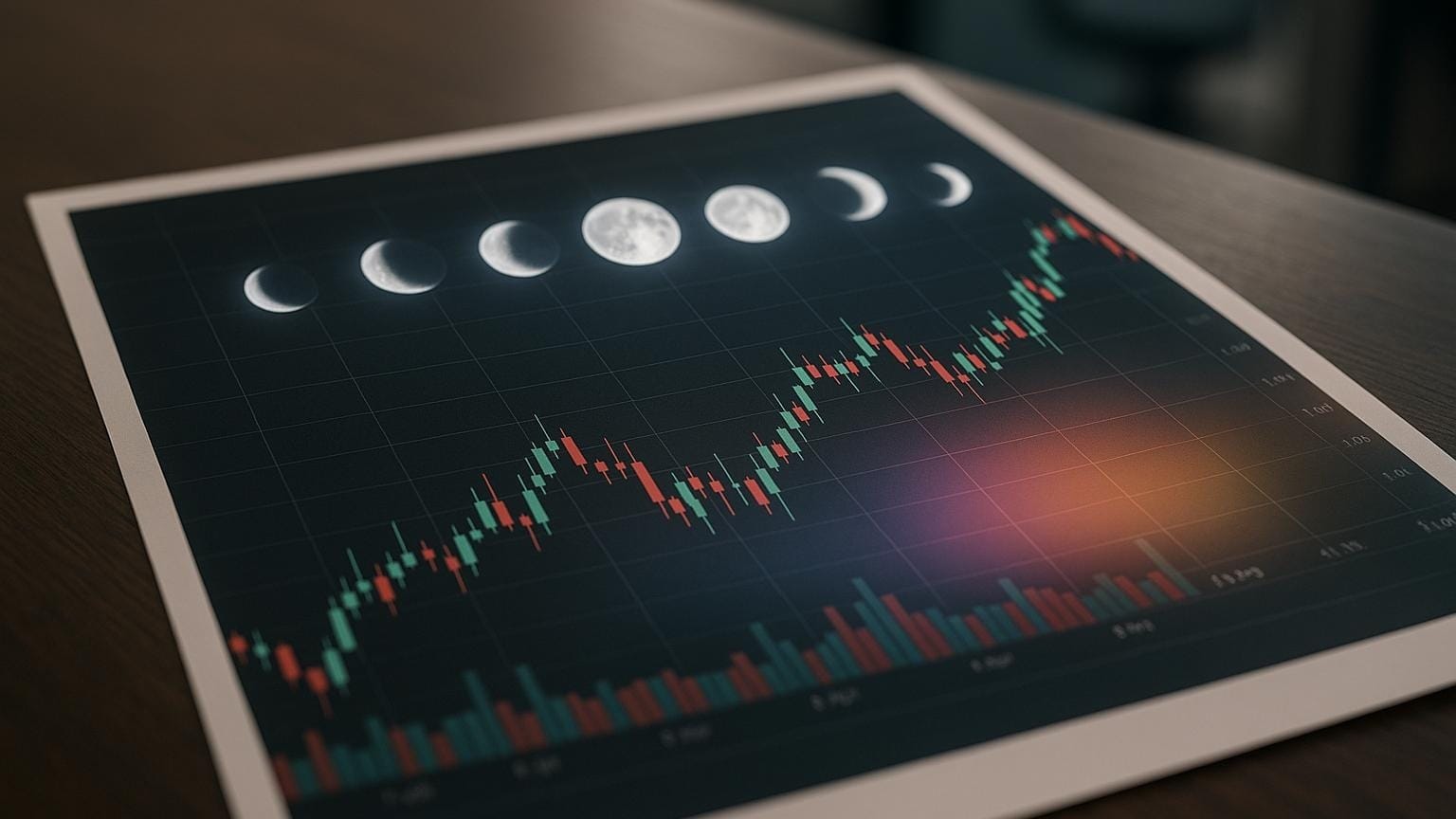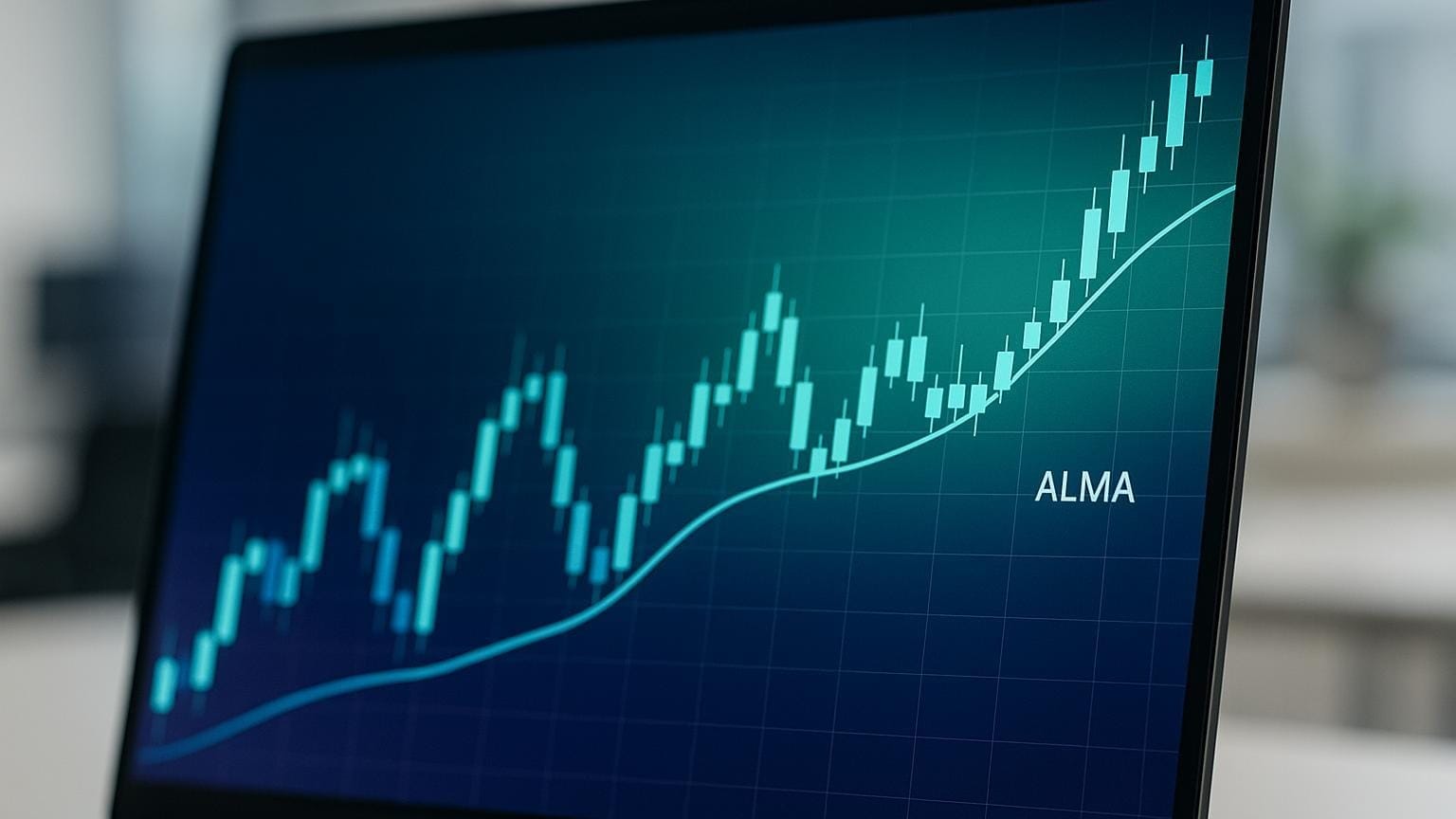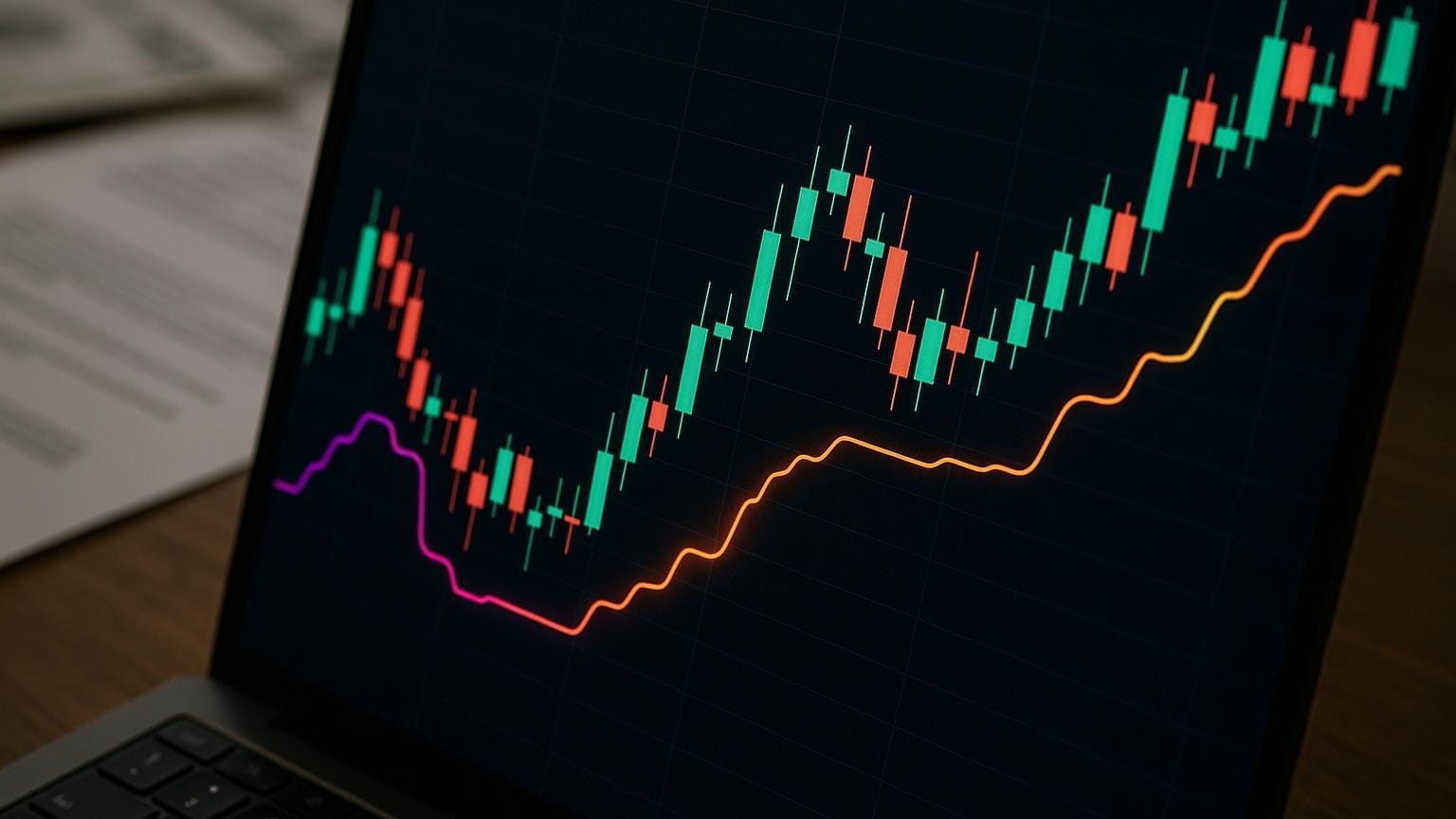Explore the intriguing relationship between moon phases and trading strategies, while weighing the scientific validity of lunar influences on market behavior.
Moon phases in trading suggest that the lunar cycle, which impacts ocean tides, might also influence market behavior. The moon’s ~29.53-day synodic cycle includes four main phases: New Moon, First Quarter, Full Moon, and Third Quarter, each theorized to affect market trends differently. For instance:
- New Moon: Associated with potential trend beginnings.
- First Quarter: Momentum often builds.
- Full Moon: Increased volatility and possible reversals.
- Third Quarter: Linked to consolidation and trend weakening.
Some traders use moon phases as a timing tool, going long during waxing phases (New to Full Moon) or short during waning phases (Full to New Moon). However, studies show no consistent evidence that lunar cycles reliably impact stock prices. Critics argue that market movements are driven by tangible factors like supply, demand, and economic policies—not celestial patterns.
Platforms like TradingView and LuxAlgo let you visualize data on charts and build rules-based approaches. If you experiment with lunar timing, always pair it with robust technical indicators, backtest thoroughly, and prioritize risk management.
Can Moon Phases Predict Stocks? Backtests Say Yes!
How the Moon Phases Indicator Works
Moon phases indicators transform the lunar cycle into chart overlays, providing a visual way to explore potential links between moon phases and market behavior. By displaying lunar data directly on trading charts, these tools help traders identify patterns and connections that might otherwise go unnoticed.
The 4 Main Moon Phases Explained
The lunar cycle spans about 29.5 days and includes four key phases, each tied to a specific stage of the moon’s illumination. Here’s how they connect to market activity:
- New Moon: This phase kicks off the lunar cycle when the moon is completely dark. In trading, it’s often associated with fresh energy in the market and the potential for new trends to emerge.
- First Quarter: About a week after the New Moon, half of the moon becomes illuminated. Traders often view this phase as a period where momentum builds, reinforcing trends that are already underway.
- Full Moon: As the moon reaches its peak brightness, this phase is thought to bring increased market volatility. According to some lunar trading ideas, the Full Moon might signal opportunities for reversals or significant market shifts.
- Last Quarter (or Third Quarter): In this phase, the moon is half-illuminated but begins to wane. It’s commonly linked to market consolidation and hints at the weakening of existing trends as the lunar cycle nears its end.
Common Moon Phase Trading Strategies
Traders often align their strategies with lunar phases. For example, some opt to go long during the waxing phase (from New Moon to Full Moon) and close or reverse positions at the Full Moon. Others take a contrarian approach, entering short positions at the New Moon and exiting at the Full Moon. Another popular tactic involves leveraging the heightened volatility during Full Moon periods, using adjusted stop-loss levels or focusing on instruments that thrive in volatile conditions.
Using Moon Phases with Other Indicators
While moon phase indicators can stand alone, they become more effective when combined with traditional technical tools. For instance, a New Moon signal gains strength if the price is above upward-trending moving averages. Similarly, momentum indicators like RSI or MACD can provide additional confirmation. A bullish MACD crossover coinciding with a New Moon could present a stronger trading signal than relying on either factor individually[4].
Volume analysis also adds depth to these strategies. A noticeable spike in trading volume during New or Full Moon phases might suggest lunar transitions are influencing market sentiment. Sentiment indicators, like the Fear and Greed Index or the Put/Call Ratio, can further validate whether market behavior aligns with the anticipated lunar impact.
Platforms like TradingView and GoCharting make it easy to integrate lunar data into charts. These tools allow users to customize marker appearances and explore historical as well as upcoming lunar phases, providing valuable context for trading decisions[1][2].
Historical Performance and Market Analysis
The effectiveness of moon phase trading strategies has been a topic of debate among analysts and researchers, with studies and reports offering mixed conclusions. While anecdotal claims are plentiful, hard evidence consistently linking lunar cycles to stock price movements remains elusive. Let’s dive into the numbers and findings.
Backtested Results Analysis
Historical backtests offer a closer look at how lunar trading strategies perform over time. However, the data generally fails to establish a dependable connection between moon phases and stock price trends. The Journal of Empirical Finance highlights an important caveat about spurious relationships in historical studies, and subsequent research has produced mixed results.
Long-term backtesting, covering decades of market data, shows that moon phase strategies rarely outpace random chance. In some cases, studies suggest potential differences around Full Moons, but these findings are inconsistent and lack repeatability across different markets and timeframes. The risks of data mining in historical datasets further weaken the reliability of these strategies, casting doubt on their practical use for trading.
Moon Phase Strategies vs. Traditional Methods
When compared to established trading methods, moon phase strategies fall short. These approaches often deliver lower returns and higher volatility, primarily because they lack a solid scientific framework connecting lunar cycles to market behavior. By contrast, traditional technical and fundamental strategies are rooted in measurable economic factors and well-defined risk parameters. This stark contrast underscores why traders should be cautious about adopting lunar-based strategies.
Problems and Criticisms of Lunar Cycle Trading
Criticism of lunar cycle trading is widespread, with experts pointing out its lack of scientific credibility. Sofien Kaabar, CFA, provides a blunt assessment:
However, despite its intrigue, it lacks scientific validity and is not a reliable tool for trading.
He further cautions:
making investment decisions based on such an indicator is speculative at best and misleading at worst.
A major issue is confirmation bias—traders may focus on instances where the strategy appears to work while ignoring its frequent failures. Additionally, there’s no logical explanation for how the moon or celestial bodies could influence stock prices. Kaabar elaborates:
Unlike proven indicators that are based on mathematical principles, lunar trading has no logical mechanism explaining why planets or the moon would affect stock prices.
Market movements are shaped by tangible factors like supply and demand, corporate performance, interest rates, and economic policies—none of which have any proven link to lunar phases. Any patterns that seem to emerge in historical data are likely the result of statistical noise rather than actionable insights, making lunar trading a highly speculative and unreliable approach.
Practical Implementation with Modern Trading Tools
Some traders incorporate moon phase indicators into their broader analytical toolkit. If you’re curious about this approach, modern trading platforms can help you apply it systematically while maintaining solid risk management practices.
Setting Up the Moon Phases Indicator
Many trading platforms, like TradingView, offer moon phase indicators through built-in libraries or add-ons. By searching “moon phases” in the indicators section, you can find tools that plot lunar cycle markers—new moons, full moons, and the phases in between—directly onto your price charts.
To avoid overwhelming your analysis, use subtle markers or shading to keep your charts clean and focused. Ensure your time zone settings align with market hours so that lunar phase data matches your trading schedule. This setup allows the indicator to complement your technical analysis rather than dominate it. From there, refine your process by observing how lunar phases interact with market behavior.
Best Practices for Effective Usage
Moon phase analysis works best as a supplementary tool, not a standalone strategy. Begin by observing how price reacts around lunar phases in your chosen markets without rushing to make decisions based solely on these patterns.
Keep a trading journal to track market behavior during lunar phases over several months. This practice can help you spot potential patterns in your specific instruments and timeframes while minimizing confirmation bias.
Always pair lunar insights with traditional indicators like moving averages, RSI, or support and resistance levels. Longer timeframes, such as daily or weekly charts, often reveal trends that shorter ones might miss. However, remember that any observed patterns could be coincidental rather than indicative of a causal relationship.
To enhance your analysis, you might consider integrating advanced tools for a more systematic approach.
Using LuxAlgo’s Moon Phases Indicator

The LuxAlgo Moon Phases Strategy on TradingView plots 🌑 New Moon and 🌕 Full Moon markers directly on price charts and can optionally trigger entries based on lunar events. You can choose whether buy and sell conditions respond to New Moons, Full Moons, or to whether price at the most recent lunar event was higher or lower than the previous one (“Higher/Lower Moon”). Background coloring helps you visualize the active bias on chart.
How it works (under the hood): The script sets a reference New Moon timestamp and the synodic period, then computes the current phase with a modulo operation. New Moon events are detected by a phase crossover, and labels are drawn at each event; strategy entries flip long/short when your selected condition occurs.
// excerpt — © LuxAlgo (CC BY-NC-SA 4.0)
cycle = 2551442876.8992
diff = (new + time + 86400000*2) % cycle / cycle
newmoon = crossover(diff, .5)
plotshape(newmoon ? low : na, "New Moon", location=location.top, text="🌑")
How to use it:
- Add the indicator from the LuxAlgo Library page.
- In settings, pick Buy/Sell triggers (e.g., Buy on Full Moon, Sell on New Moon).
- Customize highlight colors to keep charts readable.
- Validate ideas with AI Backtesting and review workflows in the Backtesting Assistant docs before risking capital.
Tip: You can complement lunar experiments with other LuxAlgo resources like Price Action Concepts (PAC), the Signals & Overlays (S&O) and OSC toolkits, screeners, and historical correlation tools.
Limitations and Final Considerations
Understanding the Risks and Limitations
The biggest issue with moon phase trading is its lack of scientific backing. Market movements are shaped by tangible factors like corporate earnings, interest rates, geopolitical events, and investor sentiment—not celestial patterns. Studies of historical data consistently fail to find any statistical connection between lunar cycles and stock prices. Any patterns observed are likely coincidental.
There’s also no logical explanation for how lunar phases could influence stock prices when these fundamental drivers dominate market behavior. Psychological biases, like confirmation bias, can also come into play, making traders recall successes while ignoring failures. Furthermore, the irregularity of lunar cycles complicates implementation. Hypothetical backtesting, often skewed by hindsight bias, offers limited reliability for future performance.
The Need for Diversified Analysis
Given these risks, it’s essential to base trading decisions on a diversified set of proven tools. Successful traders know that relying on a single indicator—especially one without a solid foundation—is a recipe for disappointment. If moon phases are considered at all, they should only serve as a minor supplement to trusted technical and fundamental analysis methods.
Focus on data-driven indicators like moving averages, RSI, and MACD, alongside economic reports and earnings data. These tools provide the real context that drives price movements.
“You should focus on proven technical and fundamental analysis methods rather than relying on financial astrology, which is based on superstition rather than data-driven insights.” — Sofien Kaabar, CFA
If you’re curious about lunar timing, treat it as an experimental tool rather than a primary strategy. Use higher timeframes to minimize noise, but always anchor decisions in market fundamentals.
Key Takeaways for Traders
Moon phase trading is speculative at best and should never replace proven methods. If you decide to explore it, conduct thorough backtesting to understand its historical performance and limitations[3]. Always remember that economic events, market conditions, and geopolitical factors have far greater influence than lunar phases.
Risk management is non-negotiable. Never commit significant capital to lunar-based strategies, and always use position sizing that protects your overall portfolio.
“While the moon phase strategy provides an interesting approach, traders should integrate it with other analysis methodologies to enhance predictability and profitability in volatile markets.” — LuxAlgo
Ultimately, disciplined risk management and evidence-based analysis are the cornerstones of trading success. Use lunar insights as a minor observational tool, documenting any patterns you notice while maintaining a healthy dose of skepticism. For major investment decisions, consult qualified financial professionals, and remember that sustainable success comes from grounded strategies—not celestial speculation.
Keep your expectations realistic and your risk exposure minimal if you decide to experiment with lunar cycle trading. The markets reward decisions built on solid evidence, not on the mysteries of the moon.
FAQs
How can traders combine moon phase indicators with traditional tools to improve their trading strategies?
Traders can use moon phase indicators alongside traditional tools to bring an extra layer of insight to their strategies. For example, some traders see new moons as potential bullish signals, while full moons might suggest reversals or increased volatility. Pairing these lunar observations with tools like the Relative Strength Index (RSI) or moving averages can help confirm trends or fine-tune entry and exit points.
By combining lunar cycles with established indicators, such as those tracking volatility or momentum, traders might develop a deeper understanding of market movements. This approach not only aids in timing trades but also boosts confidence in decision-making, all while prompting a thoughtful assessment of how effective this method is across varying market conditions.
What are the main challenges of using moon phases in trading, and how can traders approach these strategies effectively?
One of the biggest hurdles in using moon phases for trading is the lack of solid, scientific proof that lunar cycles consistently influence financial markets. Studies on this topic often produce mixed or uncertain results, making it hard to rely on these strategies as a dependable trading method. On top of that, psychological factors like confirmation bias can trick traders into spotting patterns that don’t hold up statistically.
To use moon phase strategies wisely, it’s best to treat them as add-ons, not the core of your trading plan. Backtesting these approaches with historical data is crucial to see how they perform and to ensure they fit alongside more proven, data-driven trading techniques. Keeping a skeptical eye and avoiding too much dependence on lunar cycles can help traders stay grounded and make smarter, well-rounded decisions.
How reliable are moon phase indicators in trading, and what should traders consider before using them?
Market patterns have sometimes been associated with moon phases, showing slightly lower returns around full moons and better performance near new moons. That said, these patterns are usually minor, inconsistent, and don’t reliably beat well-established trading strategies.
If you’re considering lunar-based strategies, tread carefully. They often come with high volatility and limited predictive reliability. Treat them as secondary tools to complement your main approach, and always prioritize strong risk management when testing out these methods.
References
LuxAlgo Resources
- Moon Phases Strategy — Trading Indicator
- Market Structure (Intrabar) — Trading Indicator
- Multi-Chart Widget — Trading Indicator
- Liquidation Levels — Trading Indicator
- Understanding Moving Averages and How Traders Use Them
- Volume Forecasting — Trading Indicator
- Market Sentiment Technicals — Trading Indicator
- AI Backtesting Assistant (Platform)
- AI Backtesting Assistant — Docs
- Historical Correlation — Trading Indicator
- Price Action Concepts (PAC) — Trading Indicator
- Signals & Overlays (S&O) — Trading Indicator
- Market Structure Oscillator (OSC) — Trading Indicator
- PAC Screener — Trading Indicator
- AI Backtesting Assistant — Feature Breakdown (Blog)








